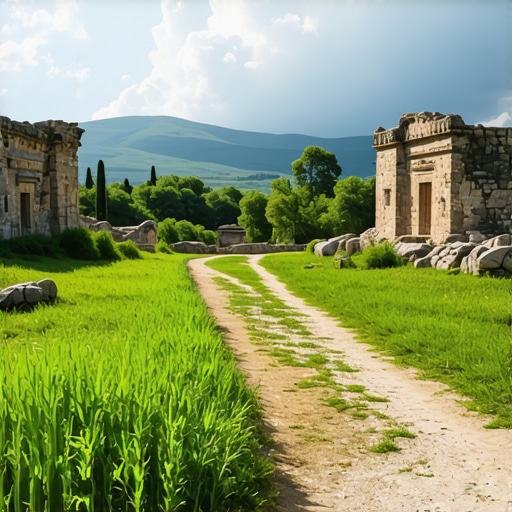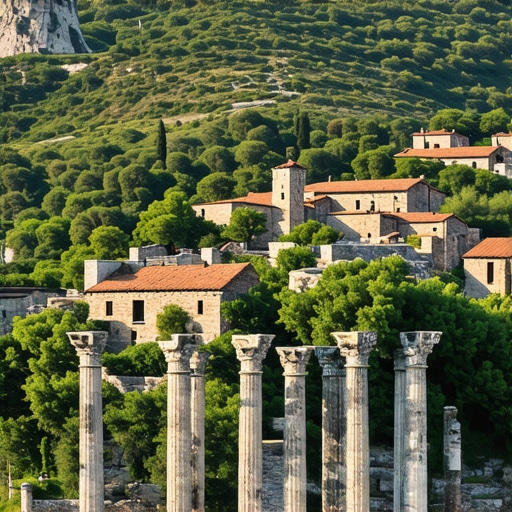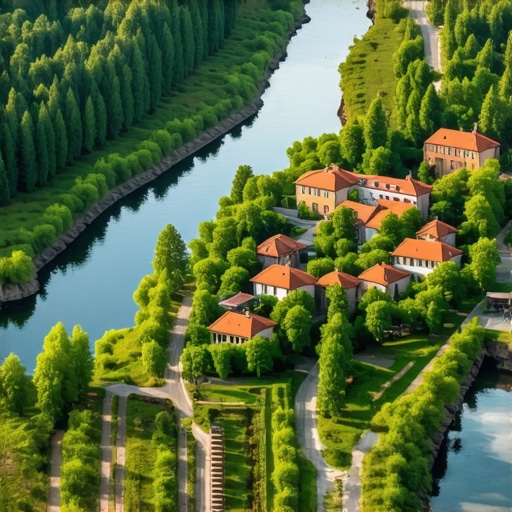Një Fillim Magjik në Vrnjačka Banja
Kur mbërrita për herë të parë në Vrnjačka Banja, ndjeva një ndjesi të veçantë të qetësisë dhe magjisë së natyrës së papërshkrueshme. Si një adhurues i aventurave natyrore dhe relikeve të lashta, kjo destinacion ishte padyshim një perlë e fshehur në zemër të Serbisë që më befasoi me bukurinë e saj të rrallë dhe trashëgiminë e pasur kulturore.
Peisazhet e Përsosura dhe Aventurat e Natyrës
Peisazhet e Vrnjačka Banja janë një mrekulli e vërtetë. Malet e larta, pyjet e dendur dhe uji i pastër i burimeve termale krijojnë një ambient ideal për ecje, shëtitje me biçikletë dhe eksplorim. Unë personalisht u dashurova me shëtitjet në natyrë dhe ndjenjën e freskët që më jep kjo zonë. Për më shumë, mund të eksploroni edhe rrugët e fshehta të malit të Zi, ku natyra është e paprekur dhe peisazhet janë të mahnitshme.
Reliket e Lashta dhe Trashëgimia Kulturore
Një nga elementët më të veçantë të Vrnjačka Banja janë reliket e lashta që datojnë nga kohërat romake dhe bizantine. Unë kurrë nuk kam parë një përzierje të tillë të historisë së lashtë dhe natyrës së fuqishme në një vend të vetëm. Këto relike janë të shpërndara nëpërmjet qytetit dhe janë dëshmi të pasurisë së trashëgimisë kulturore të Serbisë. Për më shumë rreth relikeve dhe historisë së këtij vendi, mund të lexoni këtë artikull të Sigurimeve Kulturore në [kulturen e Ballkanit](https://sq.eturizam.net/kultura-dhe-historia-e-ballkanit-shqiperi-mali-i-zi-dhe-me-shume).
Si mund të zbulojmë më shumë për thesaret kulturore të këtij rajoni?
Kërkimi i relikeve të lashta dhe kulturës së pasur është një eksperiencë jashtëzakonisht e pasur. Nëse dëshironi të mësoni më shumë për thesaret kulturore të Ballkanit, ju rekomandoj të eksploroni më shumë përmes udhëzuesve të specializuar ose të kontaktoni ekspertë në këtë fushë. Për ndonjë herë, udhëtimet në vende historike si Vrnjačka Banja na ndihmojnë të kuptojmë më mirë trashëgiminë e pasur të rajonit tonë.
Gjithashtu, ju ftoj ta ndani eksperiencat tuaja në commentet poshtë ose të eksploroni më shumë vendet e bukura që na ofron kjo pjesë e Europës. Është një destinacion që meriton të zbulohet plotësisht dhe të shijojë çdo sekondë të aventurës tuaj.
Deepening the Journey into Balkan Heritage and Nature
Building on the enchanting landscapes and ancient relics of Vrnjačka Banja, it’s vital to understand how these sites reflect the complex tapestry of Balkan history and culture. The region is a mosaic of influences, from Roman and Byzantine legacies to Ottoman traditions, each leaving a unique imprint on the landscape and architecture. For instance, exploring cultural and historical sites across the Balkans reveals stories of resilience and diversity that continue to shape modern identities.
What are the most effective ways to uncover and preserve these cultural treasures for future generations?
Preservation of cultural heritage requires an integrated approach involving local communities, historians, and policymakers. Engaging in responsible tourism can ensure that visitors appreciate these sites without causing damage. Initiatives like UNESCO World Heritage designations help safeguard iconic landmarks, but community-led efforts are essential for local sites. For example, in cities like Kotor or Berat, traditional crafts and architecture are maintained through local artisans and cultural festivals, fostering a sense of pride and continuity. To deepen your understanding, consider exploring detailed guides on regional heritage, such as the cultural and historical richness of the Balkans.
Practical Steps for Cultural Enthusiasts and Travelers
If you’re passionate about uncovering the hidden gems of the Balkans, it’s advisable to plan visits around local festivals and traditional events that celebrate heritage and crafts. These occasions provide authentic insights into the living culture, from folk music and dance to culinary traditions. For instance, the festivals in Greece, Kosovo, and Turkey showcase the diverse cultural expressions within the region. Moreover, engaging with local guides and historians enriches the experience and ensures respectful and meaningful exploration.
To further explore the region’s diverse landscapes and historical sites, I recommend browsing our detailed guides on tourist destinations in Albania and neighboring countries. These resources help craft a comprehensive itinerary that balances nature, history, and cultural immersion.
Finally, I invite you to share your experiences or ask questions about exploring the Balkans’ treasures—your insights can inspire others to embark on their own adventures. For more inspiration, check out our curated articles on South-Eastern Europe’s hidden gems. Together, we can keep the spirit of discovery alive and foster a deeper appreciation for this vibrant region.
Exploring the Depths of Balkan Heritage and Natural Beauty
As I delved deeper into the rich tapestry of Balkan history and landscapes, I realized that each site and tradition carries layers of stories waiting to be uncovered. The region’s diverse influences—from the Roman remnants to Ottoman legacies—create a mosaic that is both complex and profoundly inspiring. Visiting places like cultural and historical sites across the Balkans offers a glimpse into resilience and adaptability that define the region’s identity.
During my travels, I was struck by how local communities actively participate in preserving their heritage. In cities such as Kotor or Berat, traditional crafts, architecture, and festivals are not just relics of the past but living traditions that connect generations. Engaging with artisans or attending local festivals reveals the vibrant spirit that sustains these customs. It made me ponder: How can responsible tourism further support these efforts without disrupting their authenticity? This is a question that many of us passionate about cultural preservation should consider.
The Art of Preserving Balkan Treasures for Future Generations
One of the most effective ways to safeguard these treasures is through community-led initiatives combined with international recognition, such as UNESCO World Heritage designations. Yet, the true strength lies in empowering local populations to take ownership of their cultural assets. For example, in cities like Kotor or Berat, traditional crafts are thriving because artisans are supported and celebrated through festivals and local markets. This approach fosters pride and ensures that the cultural identity remains vibrant amidst modern changes.
Moreover, exploring the diverse landscapes and historical sites of the Balkans helps us understand the depth of this heritage. It reminds us that preservation is not only about protecting stones and artifacts but also about nurturing the living stories and traditions that continue to shape the region.
Deepening Connection Through Personal Experiences and Engagement
Personally, I found that immersing myself in local festivals, such as folk music or traditional dances, transformed my understanding from superficial sightseeing to meaningful engagement. These moments reveal the soul of a community, its struggles, and its triumphs. I encourage fellow enthusiasts to plan trips around such events, fostering genuine connections and learning firsthand about the cultural fabric of the Balkans.
To deepen your exploration, consider browsing guides like the comprehensive regional guides. Sharing your experiences and questions in comment sections can also inspire others and create a collective journey of discovery. After all, the true treasure of the Balkans lies not only in its ancient relics but in the stories, traditions, and people that keep its spirit alive.
< >
>
Reflections on Preserving the Living Heritage of the Balkans
As I continue to explore the rich tapestry of Balkan culture and history, I am struck by how deeply intertwined the region’s natural landscapes and its living traditions truly are. Each site, from ancient ruins to vibrant festivals, embodies layers of stories that span centuries. My encounters with local artisans in Kotor and Berat, for example, have shown me that preservation is not merely about safeguarding artifacts but nurturing the ongoing life of traditions that define regional identity. Engaging with these communities has reinforced my belief that responsible tourism must prioritize empowerment and respect, ensuring that future generations inherit a vibrant, living heritage rather than a static museum piece.
The Complexity of Balkan Architectural and Cultural Identity
One of the most fascinating aspects of Balkan heritage is its architectural diversity, which vividly reflects centuries of influence—from Roman mosaics to Ottoman mosques and Austro-Hungarian palaces. This mosaic is brilliantly exemplified in cities like Prizren and Ulcinj, where each structure tells a story of resilience and cultural fusion. The challenge lies in balancing modernization with preservation. Initiatives supported by UNESCO, such as the protection of historic towns, serve as vital frameworks, but the true strength comes from local communities actively participating in maintaining their cultural landscapes. For a deeper understanding of these complex identities, exploring the cultural and historical sites across the Balkans offers invaluable insights.
How can regional stakeholders effectively collaborate to safeguard these multifaceted identities?
This question is central to ensuring the sustainability of Balkan heritage. Effective collaboration involves integrating local knowledge with international expertise, fostering community-led initiatives, and securing legal protections. For instance, traditional crafts are thriving through festivals and local markets, where artisans like those in Kotor are celebrated and supported. Such grassroots efforts, combined with strategic policies, create a resilient framework for preservation. To learn more about successful models, I recommend reviewing regional cultural preservation strategies. I encourage fellow enthusiasts to share their experiences or questions about these collaborative efforts; your insights can inspire innovative solutions for the future.
Deepening Engagement Through Personal Encounters and Responsible Tourism
In my journeys, I have found that immersing oneself in local festivals, folk music, and traditional dances transforms mere sightseeing into meaningful cultural exchange. Attending the Albanian festivals in Berat or the folk dances in Prizren allowed me to connect authentically with community narratives, revealing the resilience and vitality of Balkan traditions. Such experiences underscore the importance of responsible tourism—travel that respects local customs and actively contributes to community welfare. Engaging with local guides and artisans not only enriches the experience but also ensures that the benefits of tourism are shared equitably. For practical tips on integrating responsible travel into your explorations, exploring detailed regional guides like the comprehensive Balkan travel resources is invaluable. I invite you to reflect on your own experiences and consider how your travels can support the enduring vitality of Balkan heritage.
The Future of Balkan Heritage: Challenges and Opportunities
Looking ahead, the preservation of Balkan heritage faces numerous challenges—from urban development pressures to climate change impacts. Nonetheless, these obstacles also present opportunities for innovation. Digital technologies, such as 3D modeling and virtual reality, hold promise for documenting and sharing heritage sites globally. Community engagement remains at the heart of these efforts; empowering local populations to take ownership of their cultural assets is essential. Initiatives like community-led restorations or cultural festivals can foster pride and ensure that traditions remain vibrant amidst modern transformations. Exploring these innovative approaches can inspire us all to participate actively in shaping the sustainable future of Balkan heritage. I encourage you to consider how your own role—whether as a traveler, researcher, or advocate—can contribute to this vital mission.
< }
}
Things I Wish I Knew Earlier (or You Might Find Surprising)
Një pasuri e fshehur që e nënvlerësonim
Një nga mësimet më të mëdha që kam marrë nga eksplorimi i Ballkanit është se shumë nga thesaret kulturore dhe natyrore janë ende të papërshkrueshme përmes fjalëve. Më parë, nuk e kuptonim sa shumë pasuri të trashëgimisë sonë janë përballë rrezikut të harresës ose shkatërrimit, por tani e kuptojmë se çdo qytet, kështjellë ose peisazh është një kapitull i rëndësishëm i historisë sonë kolektive.
Rëndësia e përfaqësimit të trashëgimisë së gjallë
Pas përvojës sime, kam kuptuar se trashëgimia nuk është vetëm për t’u ruajtur në muze, por është pjesë e jetës së përditshme të komuniteteve. Festat tradicionale, artizanati dhe këngët e lashta janë mënyra më të fuqishme për të ndjerë thellësinë e identitetit tonë kulturor. Për shembull, festivalet në qytetet si Berat ose Kotor janë jo vetëm një shfaqje e traditës, por edhe një thirrje për ruajtjen e këtij trashëgimie të gjallë.
Si mund të bashkëjetojmë me ndryshimet pa humbur identitetin tonë?
Një nga sfidat kryesore është gjetja e balancit midis zhvillimit modern dhe ruajtjes së trashëgimisë. Mënyra më e mirë është angazhimi i komuniteteve lokale në mbrojtjen e pasurisë së tyre dhe përdorimi i teknologjisë për dokumentim dhe promovim. Për shembull, përdorimi i teknologjisë së 3D-së për regjistrimin e monumenteve historike ose krijimi i platformave dixhitale për tregti të artizanatit mund të ndihmojë në ruajtjen e identitetit tonë të përbashkët pa e humbur atë në ndryshime të shpejta.
Udhëtime që ndryshojnë perceptimin
Gjatë udhëtimeve të mia, kam vërejtur se pjesëmarrja në festa dhe aktivitete lokale ofron një kuptim shumë më të thellë për kulturën. Këto përvoja më kanë bërë të ndiej se sa e rëndësishme është të ndihmojmë komunitetet që të mbajnë gjallë traditat e tyre për breza të ardhshëm. Për shembull, ndjekja e festivalit të muzikës folklorike në Prizren më dha një ndjenjë të veçantë lidhjeje me historinë dhe identitetin e rajonit.
Resources I’ve Come to Trust Over Time
- UNESCO World Heritage Center: Një burim i besueshëm për njohjen dhe mbrojtjen e vendeve të trashëgimisë botërore, që më ka ndihmuar të kuptoj rëndësinë e përfshirjes së komuniteteve në ruajtje.
- European Heritage Alliance: Rrjet i organizatave që promovojnë trashëgiminë evropiane, duke ofruar udhëzime dhe projekte që lidhen me trashëgiminë kulturore dhe natyrore.
- Google Arts & Culture: Një platformë inovative që ofron ekspozita virtuale dhe histori, duke e bërë më të lehtë për mua të eksploroj pasuritë kulturore nga shtëpia.
- National Geographic: Një burim i shkëlqyeshëm për fotografi dhe historia të pasura natyrore dhe kulturore, që më ka frymëzuar të vizitoj vende të reja.
Parting Thoughts from My Perspective
Në fund të ditës, ajo që më ka mësuar më shumë është se trashëgimia kulturore dhe natyrore e Ballkanit është thesari jonë më i madh. Është detyra jonë të ruajmë dhe të promovojmë këtë pasuri për brezat e ardhshëm, duke e bërë këtë me respekt dhe përkushtim. Udhëtimi nëpër këtë rajon më ka mësuar se çdo vend, çdo qytet dhe çdo peisazh ka një histori unike për të treguar, dhe është përgjegjësia jonë ta ndajmë këtë trashëgimi me botën. Nëse ky artikull ju ka frymëzuar të eksploroni më shumë ose të mbroni trashëgiminë tuaj, ju ftoj të ndani mendimet dhe përvojat tuaja — së bashku, mund ta bëjmë këtë botë një vend më të bukur dhe më të pasur kulturërisht.

